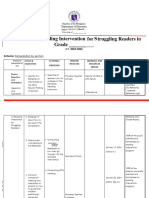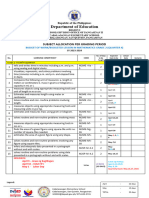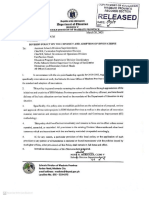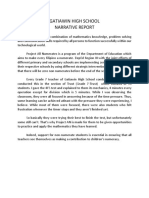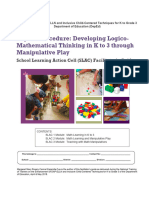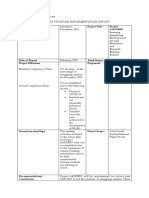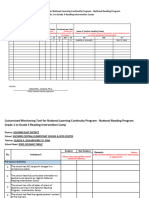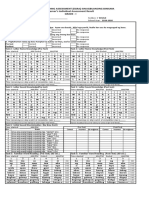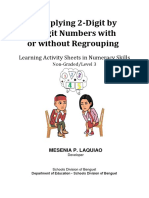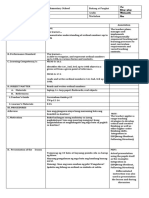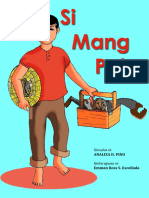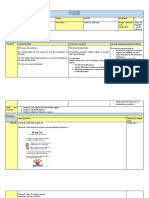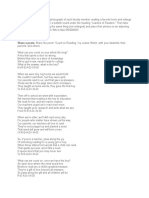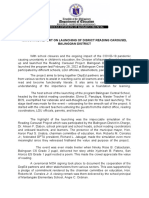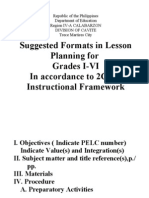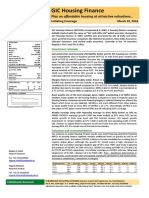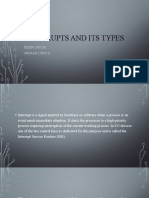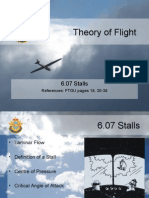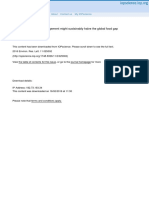Capacity Building of Key Stage 1 Teachers on
Learning Recovery in Literacy and Numeracy
Module 2
Session 1
Learning More About Dissimilar Fractions
� Module 2
Session 1
MODULE NO 2 SESSION 1
SESSION TITLE: Learning More About Dissimilar Fractions
SESSION OBJECTIVES:
Terminal Objective:
The highly proficient teachers shall be able to model and share effective
techniques and the proficient teachers shall be able to develop activities that will
apply strategies in the management of classroom structure to engage learners,
individually or in groups, in meaningful exploration, discovery and hands-on
activities in visualizing, representing and arranging dissimilar fractions in
increasing or decreasing order.
Enabling Objectives:
1. Discuss the different engaging teaching strategies on visualizing, representing and
arranging dissimilar fractions in increasing or decreasing order
2. Apply a range of teaching strategies that enhance learner achievement in visualizing,
representing and arranging dissimilar fractions in increasing or decreasing order in
developing different activities
3. Share reflections on practices which are effective in teaching visualizing,
representing and arranging dissimilar fractions in increasing or decreasing order
CONTENT: Visualizing, Representing and Arranging Dissimilar Fractions in
Increasing or Decreasing Order
ESTIMATED TIME REQUIRED: 4 hours
2
� Module 2
Session 1
Introduction
Dear Mathematics enthusiast! Put on your thinking cap as you walk your way
through this module. We know that you’ve been our partner in developing the
numeracy skills of our learners. This time, we will focus on a least mastered
competency from the result of the Early Language and Numeracy Assessment. We
have here some suggested activities that you may consider in your class to address
this competency. We have also added different teaching strategies that will help you
in your professional development that may provide you the leeway to look deeper
into the different aspects that need to be improved.
We hope that you will enjoy this journey of learning the module and will be
successful in applying these new strategies that will awaken your commitment to be
most effective in teaching visualization, representation and arranging dissimilar
fractions.
TARGET INDICATORS & COMPETENCY
In this module, we will focus on:
Strand 1.4.2 1.4.2 Use a range of teaching strategies that enhance learner
achievement in literacy and numeracy skills.
Strand 2.3.2 2.3.2 Manage classroom structure to engage learners, individually or
in groups, in meaningful exploration, discovery and hands-on
activities within a range of physical learning environments
Strand 2.3.3 2.3.3 Work with colleagues to model and share effective techniques in
the management classroom structure to engage learners, individually
or in groups, in meaningful exploration, discovery and hands-on
activities within a range of physical learning environments
3
� Module 2
Session 1
Overview
, , , ?
Teachers are advocates of numeracy. As teachers, it is important that you
know the key concepts to explore the teaching and learning of numeracy in
mathematics classes. Numeracy is proficiency in number senses. Thus, it is another
form of literacy.
One basic numeracy skill is understanding fractions, which is a prerequisite
for developing more complex mathematical abilities. However, many students find it
difficult to become proficient with fractions, especially those who struggle with
arithmetic and frequently lack a solid foundation in whole numbers.
The underlying distinctions between whole numbers and fractions have long
been thought to be the cause of fractional difficulties. This may result in whole-
number bias, which is the overgeneralization of whole-number knowledge to fractions
by students. This causes students to assimilate whole-number concepts into their
understanding of fractions, which in turn causes misconceptions about fractions
because whole numbers and fractions have different properties.
For instance, fractions are represented by two numerals and a fraction bar,
but whole numbers are represented by a single numeral. Students frequently
understand fractions as two separate numbers rather than seeing them as one, which
is a typical error brought on by whole- number bias.
This module is developed where you will also reflect on your practices and try
to use a range of learner-centered strategies that will enhance their literacy and
numeracy skills and will have classroom management structure to engage learners,
individually or in groups, in meaningful exploration, discovery and hands-on
activities within a range of physical learning environments to teach dissimilar
fractions.
4
� Module 2
Session 1
Self-Reflection
You will now reflect on your teaching strategies and learning activities in
relation to the identified least mastered competency and how you apply the given
PPST indicators in your Mathematics class.
As a Proficient Teacher…
… I know a range of teaching strategies that enhance learner
I know... achievement in literacy and numeracy skills and how to manage
classroom structure to engage learners, individually or in groups, in
meaningful exploration, discovery and hands-on activities within a
range of physical learning environments in teaching dissimilar
As a Proficient Teacher…
… I feel that it is important to equip learners with the basic
I feel... foundations to develop their numeracy skills and that they will learn
best and learning is more permanent if they will acquire knowledge
through meaningful exploration, discovery and hands-on activities.
As a Proficient Teacher…
… I do apply a range of teaching strategies that enhance learner
I do...
achievement in literacy and numeracy skills and how to manage
classroom structure to engage learners, individually or in groups, in
meaningful exploration, discovery and hands-on activities within a
YOUR TURN!!!
Write your reflections below. This will be done after finishing the module
I know... I feel... I do...
As a Proficient Teacher… As a Proficient Teacher… As a Proficient Teacher…
. . .
5
� Module 2
Session 1
SUPPORT GROUP
A PIECE OF CAKE
Teacher Gigi is teaching her class about dissimilar fractions. She brings 2
round cakes of the same size to use as her concrete example. The first cake is
chocolate while the other one is ube. She cuts the chocolate cake into 8 equal parts
while she cuts the ube cake into 4 equal parts.
She gives 4 slices of chocolate cake and 3 slices of ube cake to her pupils. Then
she asked her pupils, which do they eat more? The chocolate cake or the ube cake?
PROBING QUESTIONS:
1. Will Teacher Gigi be able to teach dissimilar fractions using the piece of
cake as an example?
2. Why do you think it is difficult teaching “Visualizing, representing and
arranging dissimilar fractions”?
3. When you are teaching this competency, what went well and what went less
during your class discussion?
4. Have you identified some misconceptions in teaching this topic? What are
they and how did you address such misconceptions?
5. If you were Teacher Gigi, how will you teach this competency to your
learners especially to those who are not confident in fractions?
6
� Module 2
Session 1
Key Concepts
ARRANGING FRACTIONS
*Arranging individual fractions from the lowest value to the highest one, or the
other way around
*Starts with the process of comparing one fraction to another, so that the bigger
or smaller parts of a whole can be identified
DISSIMILAR FRACTIONS
*Are fractions with different denominators
EXPLORATION
*An active learning approach which helps learners learn through curiosity and
inquiry
HANDS-ON ACTIVITIES
*Offer learners unique learning opportunities that paper and pencil tasks simply
just can’t. It is an approach is the idea that students need to feel and touch
what their learning through a concrete learning experience before they are
exposed to more of the abstract learning
NUMERACY
*The knowledge, skills, behaviors and dispositions that students need in order
to use mathematics in a wide range of situations. It involves recognizing and
understanding the role of mathematics in the world and having the dispositions
and capacities to use mathematical knowledge and skills purposefully.
7
� Module 2
Session 1
SUGGESTED TEACHING-LEARNING ACTIVITIES:
You will now walkthrough with the different
learning activities that you may consider to make
teaching and learning delivery of dissimilar fractions
easier for our learners.
This will include meaningful exploratory,
discovery and hands-on activities to give impact to
student learning.
https://www.hiclipart.com/free-
transparent-background-png-clipart-
otpxm
1. SCAFFOLDING
Before you can deliver teaching the competency about “Visualizing,
representing and arranging dissimilar fractions”, the best way to start is to check the
foundational understanding of learners on similar fractions and its parts.
You may have mini lessons on the following:
Comparing fractions with the same numerator;
The greater the numerator, the smaller the fraction.
Comparing fractions with the same denominator;
The greater the numerator, the greater the fraction
2. USING BENCHMARK FRACTIONS
Using benchmark fractions for comparison
Fractions are placed on a number line against a benchmark
A benchmark fraction is a reference or guide for identifying other fractions. Common
fractions that are more familiar are used as benchmarks to help find the less familiar
fractions.
Once your learners have established this foundation, it is time to discuss the
competency.
Good job!
This time, you will see some of the suggested strategies about “Visualizing,
representing and arranging dissimilar fractions” on the next pages. The steps are
simplified to help you easily facilitate the delivery and it is hoped that these will give
meaningful experience to your learners.
8
� Module 2
Session 1
3. CONCRETE PICTORIAL ABSTRACT APPROACH (CPA)
Using Manipulatives/Real Objects/Illustrations/Diagrams
The Concrete Pictorial Abstract Approach is an essential tool in teaching your Key
stage 1 learners. This is where your learners build their foundational understanding
through studying concrete objects, followed by a pictorial representation before moving on
to the abstract digits and symbols.
Using real objects
Concrete (C) Using patternblocks/
geogebra/Fraction Bar
Modelling Using lego
REAL APPLES
https://www.shutterstock.com/image-
photo/six-red-apples-isolated-on-white-
1028826493
Using drawings/illustrations
*Visual
Pictorial (P)
Representations/
Using fraction strips
& different shapes
Partitioning Set
PICTURE OF APPLES Models)
https://www.pngitem.com/middle/bxTw
Rb_apple-png-clipart-apple-clipart-six-
apples-cartoon/
Using numbers and symbols
Abstract (A) 6 apples
(Fractional symbols)
You will introduce “Visualizing, representing and arranging dissimilar fractions in
increasing or decreasing order” using any objects that your learners are familiar with.
When they are already confident with their knowledge on this competency, introduce the
use of drawings or illustrations as pictorial representations of the concrete objects you
have used. Then, you will use the numbers and symbols of a fraction. Provide enough
examples so that all learners in your class will be able to learn this lesson.
Using this CPA approach in your classes will help your learners better understand
the connection between numbers and the real world. This will secure their
understanding dissimilar fractions.
9
� Module 2
Session 1
4. FRACTION BARS
The use of fraction bars will give them idea on how they will visualize, represent
and arrange dissimilar fractions in increasing order or decreasing order.
Through the bars, your learners will be able to compare the given fractions based on
the size of the bars.
For example, fractions , , may be represented and arranged as shown below
Once you have presented these bars to your class, you can ask them to arrange the
given fractions in order.
Increasing
Decreasing
10
� Module 1
You may now create sample activities using the suggested learning activities.
Remember that the key in attaining the objective of visualizing, representing and
arranging dissimilar fractions is to develop the skills of our learners from concrete to
pictorial and pictorial to abstract. There should be a strong foundation on the basic
concepts of similar fractions for this will be used as prerequisites for dissimilar
fractions.
5. USING FRACTION MODELS
https://www.k-5mathteachingresources.com/fraction-models.html
a. Draw a shape that best represents what you are trying to model.
b. Split the shape into equal parts, the total number of portions is determined
by the denominators.
c. Shade the portions indicated by the numerator.
6. CHANGING TO SIMILAR FRACTIONS
a. Find the LCD of the given set of fractions.
b. Determine the equivalent fractions sharing the LCD.
c. Arrange the numerators of the equivalent fractions from least to greatest or
greatest to least.
11
� Module 1
SUGGESTED ASSESSMENT/LEARNING ASSESSMENT
Here are some suggested learning assessments that you may consider. You
may give these to your class at the end of the unit about dissimilar fractions.
A. Written Work on Visualizing, Representing and Arranging Dissimilar Fractions
Directions: Read each item carefully. Select the correct answer among the choices.
Write your answer on your answer sheet.
12
� Module 1
13
� Module 1
14
� Module 1
15
� Module 1
B. Performance-Based Assessment
*Using Real-life Objects/Manipulatives
Activity Title: FRACTIONS YOU CAN TOUCH (By pair or by group)
This is a very good performance-based assessment that you can give to your
pupils. Ask them to bring clay, lego and other materials.
A. Using clay
1. Ask/Guide your learners to make a small plate-size pizza using their clay
2. Guide them in making fraction pizzas which are cut in equal parts
like halves, thirds or fourths.
3. Give a fraction and randomly call a group and ask them to show that
part to the class.
4. Ask each pair/group to present their work.
16
� Module 1
B. Using Lego
1. The use of legos are great visual tools. Ask your learners to show you certain
fractions like one-half or two-thirds.
2. The groups will build their own tower using their legos.
3. The groups will take turns in building the tower.
4. Each group will roll a die twice to determine the numbers in the
fraction. The smaller number rolled will be the numerator and the
bigger number will be the denominator.
5. Use two colors of legos to create the fraction.
6. If a group rolled three-fifths, the tower could be made using 3 red legos and 2
blue logos.
7. Ask each pair/group to present their work.
Rubrics:
Timeliness: 25%
Output: 50%
Presentation: 25%
OTHER SUGGESTED STRATEGIES
A. COMPARING FRACTIONS CARD GAME
1. Learners will play by partners
2. Each student gets half a deck of cards
3. Each partner flips over one card
4. Learners compare the values of the fractions
5. The pair with the higher fraction ‘wins’ the cards
If the cards are equivalent, it’s a ‘war’ and students put down a second
card and compare these. The student with the greater fraction wins all the
cards.
6. Play continues until one player has won all the cards (or until time is up)
B. VIDEO LESSONS
Use the following links to provide your learners with additional
supplementary information.
17
� Module 1
https://www.youtube.com/watch?v=4CGEssgAIlA
https://www.youtube.com/watch?v=i2PfHDs88YE
https://www.youtube.com/watch?v=QGMvzDMZ91w
https://www.youtube.com/watch?v=jyer7KHbwvM
C. FIX IT: FRACTION PUZZLES
1. Prepare at least 10 different fractions.
2. Ask your learners to choose five fractions, none of which have
the same denominator or equal.
3. Ask the learners to write the fractions in order (maybe arranged in
increasing or decreasing order).
4. Ask your learners to present their arrangement and explain their work.
5. Based on their work, ask them to make a “Fix It Puzzle” for others to solve.
18
� Module 1
PROFESSIONAL DEVELOPMENT PLAN
Flexible Learner: School:
Goals:
1. To use a range of teaching strategies that enhance learner achievement in
literacy and numeracy skills.
2. To provide activities that will enhance competency in managing classroom
instruction to engage learners, individually or in groups in meaningful
exploration, discovery and hands-on activities with a range of physical
learning environments.
19
� Module 1
Resource Library
Cognitive Cardio Math. https://tinyurl.com/4xvjh2w2
Comparing and Ordering Similar and Dissimilar Fractions 4th Grade Math
Worksheets https://helpingwithmath.com/worksheet/comparing-and-ordering-
similar-and-dissimilar-fractions/
Learning Intranet. Curriculum Design. Teaching Strategies. https://tinyurl.com/4jbspndk
MBmath. Fix It: An Activity for Ordering Fractions.
https://marilynburnsmath.com/fix-it-an-activity-for-
ordering-fractions/
Numeracy for all Learners. Department of Education. Victoria State University.
https://tinyurl.com/t6zx3urt
The Fraction Bar Model. How to Teach Fractions Using Bar Models. Asher,
Vanessa. 2022 https://thirdspacelearning.com/blog/fraction-bar-model/
The Teacher Next Door: Fraction Activities that Students
Love. https://the-teacher-next-door.com/fraction-
activities-students-love/
What is Concrete Pictorial Abstract Approach (CPA) and How To Use It in Maths.
Johnson, Emma. 2022 https://thirdspacelearning.com/blog/concrete-pictorial-
abstract-maths-cpa/
20








